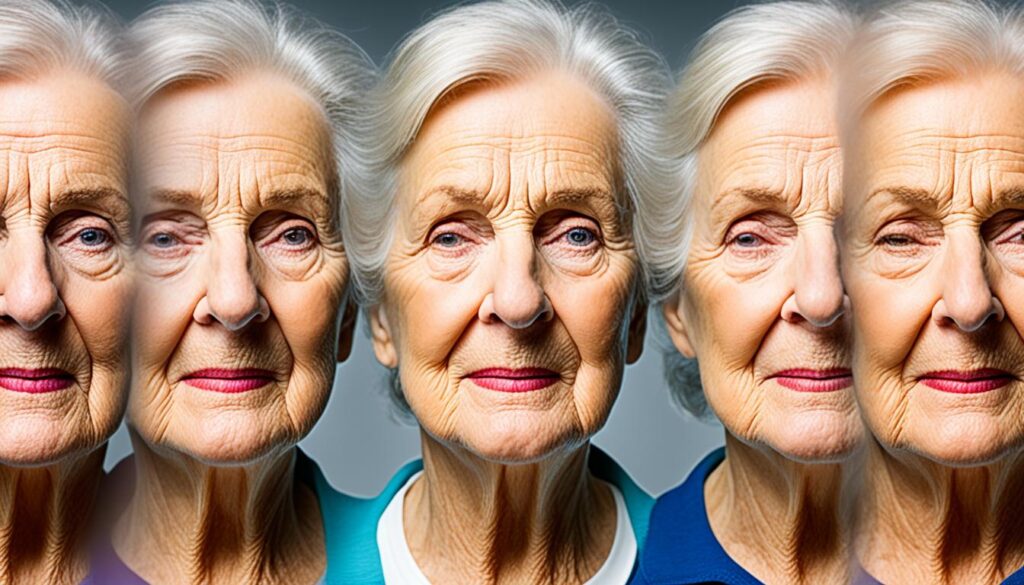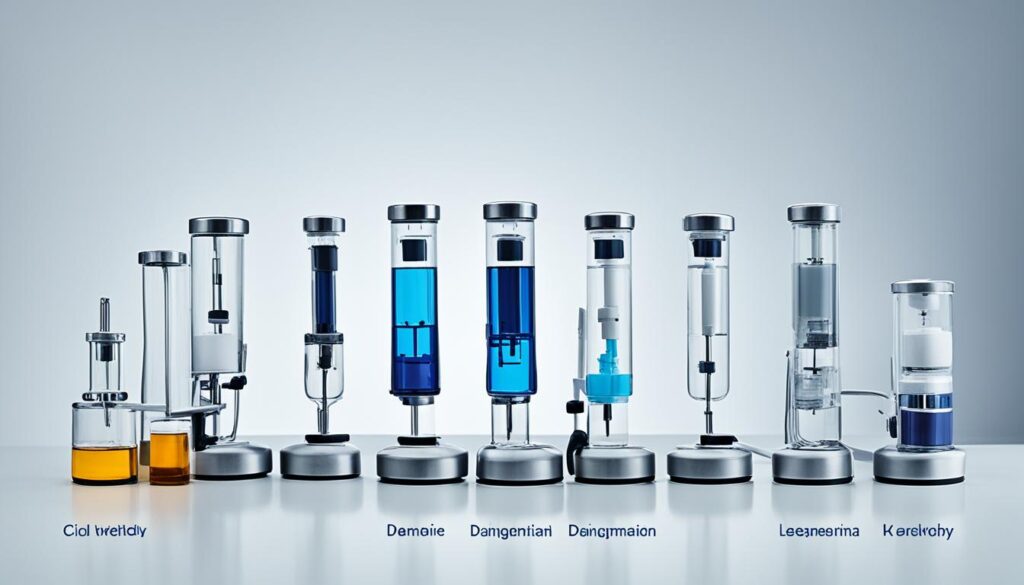About 1.4 million people in the United States are affected by Lewy Body Dementia (LBD)1. It’s the second most common type of dementia after Alzheimer’s1. This condition is tough to deal with because it gets worse over time and affects everyone differently.
The seven stages of Lewy Body Dementia help us see how the condition changes, showing different symptoms and their severity at each phase1. Let’s dig into the 7 Stages of Lewy Body Dementia.
The stages fall into three main parts: mild, moderate, and severe1. Even though we can categorize the stages, symptoms and how they impact people can vary a lot.
This makes it really important to catch the disease early and create care plans that fit each person. In these stages, you’ll learn about symptoms like thinking problems, memory issues, seeing things that aren’t there, and trouble moving1.
Key Takeaways
- LBD affects approximately 1.4 million people in the U.S1.
- It is the second most common type of dementia after Alzheimer’s1
- The disease progresses through 7 stages divided into three categories: mild, moderate, and severe1
- Symptoms vary, including cognitive decline, behavioral changes, and movement issues1
- Early diagnosis and personalized care plans are essential for managing the condition1
What is Lewy Body Dementia?
Lewy Body Dementia (LBD) is a brain disorder caused by abnormal protein accumulations. These are known as Lewy bodies. More than 1 million Americans are living with LBD2. It mainly affects how a person thinks, moves, and behaves, which highlights the need for personalized care.
Definition and Overview
LBD is a top cause of dementia, mostly hitting those 50 and up. Men get it more often than women2. How long can someone live with it? It varies. Some live just 5 to 8 years, while others might reach 20 years23.
On average, people survive 8 to 12 years after being diagnosed3. Although it can’t be cured, certain medicines can help. These include Acetylcholinesterase inhibitors and Memantine. Medications like levodopa, melatonin, and antipsychotics are also used3.
Types of Lewy Body Dementia
There are two main types of Lewy Body Dementia:
- Parkinson’s disease dementia (PDD): Shows up after Parkinson’s disease causes cognitive decline4.
- Dementia with Lewy bodies (DLB): This leads to faster decline in thinking and major behavioral and memory changes later4.
To understand how LBD can be fatal, it’s key to know it severely affects the mind and body in the end stages. This means losing the ability to talk or walk. Losing control over bladder and bowel functions is common too24. A diagnosis includes checking the patient’s psychology, blood tests, scans like MRI and CT, and genetics3.
In short, knowing about the progression of LBD and its types helps in handling it. Getting the right diagnosis and treatment helps people with LBD and their caregivers face the disease’s challenges better.
Early Symptoms of Lewy Body Dementia
Lewy Body Dementia (LBD) starts off quietly, and its early signs are hard to spot. There are common patterns though, varying from person to person. These early signals point towards the disease.
Behavioral Changes
Behavior changes are a key early sign of LBD. These might include feeling more anxious or sad, and having trouble making decisions. As LBD gets worse, these changes affect everyday life even more. People might also struggle to stay alert, causing others to misunderstand them.
This impacts a person’s thoughts and feelings deeply.
Sleep Disturbances
Sleep problems are also a clear early sign of LBD. People may not be able to sleep well and could have very real-feeling dreams. Research shows that acting out dreams is an early clue of the disease. These sleep issues can make life harder and could also harm brain function.
Physical Symptoms
Physical signs like shaking, stiffness, and movement changes are signs of LBD progressing. These might look like Parkinson’s disease symptoms, which is closely linked to LBD5. The disease does not just affect movement but can lead to major thinking problems as well.
About 1.4 million people in the U.S. have LBD6. It gets worse over time and can require constant care in later stages6.
Spotting these early signs of LBD is important for getting help quickly. This can help manage the disease better and improve life quality. It’s essential to act early because the disease will lead to major health problems65.
The 7 Stages of Lewy Body Dementia
Lewy Body Dementia progresses through 7 stages. It starts with small cognitive changes and ends in severe dementia. Knowing these stages helps us diagnose and manage the disease better.
Stage 1: Early Symptoms
In the beginning, people may notice minor memory and focus issues. Spotting these signs early on is key. This is because Lewy Body Dementia is hard to diagnose right away7.
Stage 2: Mild Cognitive Impairment
As the illness gets worse, mild thinking problems start to show. Patients may forget things sometimes and find complex tasks harder. This is the beginning of the disease8.
Stage 3: Mild Dementia
Now, memory problems get worse, along with mood swings and anxiety. At this point, people need help with day-to-day things. Caregivers notice big changes in behavior9.
Stage 4: Moderate Dementia
Thinking and memory keep getting worse. Solving problems and day-to-day tasks become much tougher. Patients often have big changes in how awake and aware they are9.
Stage 5: Moderately Severe Dementia
This stage brings severe thinking and physical issues. Most daily tasks can’t be done alone. It’s time for full-time care to manage these challenges8.
Stage 6: Severe Dementia
Severe dementia usually goes on for around 2.5 years. During this time, talking can stop, and 24/7 care is needed. Full-time support from caregivers is essential7.
Stage 7: End-Stage Dementia
The last phase, known as end-stage, lasts for 1.5 to 2.5 years. Patients lose the ability to talk and walk. They totally rely on others for daily care7. Living with Lewy Body Dementia demands a lot of care and understanding.

Symptoms of Lewy Body Dementia in Detail
Lewy Body Dementia (LBD) brings different symptoms divided into three groups: cognitive, movement, and behavioral/mood changes. Each group shows clear signs that help with diagnosing LBD. These signs show how LBD affects people in various ways.
Cognitive Symptoms
People with LBD face many thinking problems. They find it hard to make decisions, pay attention, remember things, and do more than one thing at a time. While memory loss in LBD is less severe than in Alzheimer’s, it causes mild confusion and focus issues early on10. Seeing these thinking problems early is key, as they often come before more obvious symptoms11.
Movement Symptoms
LBD also causes problems with movement similar to Parkinson’s disease. Those affected might shuffle their feet, have stiff muscles, and shake. This makes everyday tasks much harder10. Some may stand or walk with a bent back and struggle to start moving10.
Moreover, as many as 80% of people with LBD see things that aren’t there, making moving even more difficult12.

Behavioral and Mood Changes
Changes in behavior and mood are common in LBD patients. They may feel depressed, anxious, or easily upset, and these feelings often get worse12. Some may cry often because they feel very up and down in their emotions11. A lot of LBD patients also act out their dreams because of REM Sleep Behavior Disorder12. It’s very important to look after these symptoms. They greatly affect the lives of those with LBD and the people who care for them.
Diagnosis of Lewy Body Dementia
Diagnosing Lewy Body Dementia (LBD) is complex because its symptoms often resemble other dementias. It’s vital to use a detailed approach for a correct diagnosis.
Diagnostic Criteria
The first step in diagnosing LBD is to know its diagnostic criteria. These involve key symptoms like changing thinking skills, seeing things that aren’t there, and movement issues. Also, certain symptoms like REM sleep behavior disorder and a strong reaction to some medicines are clues. Spotting these signs helps to tell LBD apart from other dementia types.
Medical Tests and Imaging
Doctors use several tests to verify LBD. They usually start with blood tests and a full check-up of the body and brain. Brain scans are really important to see LBD-related changes. CT, MRI, PET, and SPECT scans show these changes clearly13. Tests for sleep problems are also done to find REM sleep behavior disorder, often seen in LBD.

Other evaluations include testing memory, speaking, and thinking skills. These help tell LBD from other brain diseases. Using various tests and scans provides a thorough and accurate diagnosis.
Treating Lewy Body Dementia
To manage Lewy body dementia, a mix of medical and non-medical plans is used to help people live better. Although no drug can cure it completely, there are many ways to help with the symptoms.
Medications
Doctors often give different medicines for the various symptoms of Lewy body dementia. Cholinesterase inhibitors can help with memory issues and confusion. Levocarb is used for movement issues like stiffness and shaking. Antidepressants may help with feeling sad or worried14. But, it’s very important to watch how antipsychotic medicines are used as they can make symptoms worse15.

Non-Medical Therapies
Along with medicines, therapies without drugs are key in treating Lewy body dementia. Physical therapy helps keep movement easy and reduce stiffness14. Occupational therapy makes daily tasks easier as the disease changes. Talking therapies and support groups help with feelings, benefiting both patients and caregivers.
Here is a sample table of the common treatments and the symptoms they target:
| Treatment | Targeted Symptoms |
|---|---|
| Cholinesterase Inhibitors | Cognitive Symptoms (Memory loss, Confusion) |
| Levocarb | Movement Problems (Rigidity, Tremors) |
| Antidepressants | Depression, Anxiety |
| Antipsychotics | Hallucinations, Delusions (use with caution) |
| Physical Therapy | Mobility, Flexibility |
| Occupational Therapy | Daily Living Skills |
| Psychotherapy | Emotional Support |
Living with Lewy Body Dementia
Lewy body dementia affects around 1.4 million Americans16. It gradually worsens cognitive and physical abilities. In the beginning, people appear fine, keeping up with daily tasks16. But as time goes on, they face more problems. They struggle with their thoughts, movements, and sleep16.

By stage 4, managing finances and remembering recent happenings becomes hard16. At stage 5, memory loss and impairments start to heavily disrupt daily life16. Stage 6 brings severe difficulties in communicating and moving, needing constant watch17. Lastly, stage 7 demands 24/7 care due to very severe cognitive decline17.
People with Lewy body dementia live between 2 to 20 years after diagnosis1718. Adapting homes for safety is key. Firms like MeasurAbilities help make living spaces safer. They offer home safety checks, fall prevention tips, and install safety aids18. Such help is vital for families dealing with Lewy body dementia.
Healthcare pros and caregivers are vital in dealing with Lewy body dementia17. Their support is crucial, offering both medical and therapeutic solutions. They help tackle the challenges that this condition brings.
| Stage | Description | Assistance Required |
|---|---|---|
| Stages 1-2 | No or very mild impairment | Minimal |
| Stage 3 | Noticeable cognitive and physical symptoms | Mild assistance |
| Stage 4 | Moderate impairment | Substantial support |
| Stage 5 | Moderately severe impairment | Help with daily tasks |
| Stage 6 | Severe impairment | Constant supervision |
| Stage 7 | Very severe impairment | Full-time care |
Caregiver Support for Lewy Body Dementia
Caring for someone with Lewy Body Dementia (LBD) is very hard. This is because of the many symptoms like memory loss, trouble moving, and mood changes19. It’s very important to give caregivers the right support so they can deal with these challenges well.
Support Groups
Joining groups for dementia support can really help. LBD is very common, affecting over a million people20. These groups let caregivers talk about what they’re going through and learn how to cope. They stress how crucial it is to be patient and understand the feelings of someone with LBD19.
These groups also share helpful info from places like the NIH and the Lewy Body Dementia Association21. This makes sure caregivers get the details they need.
Respite Care
Respite care gives caregivers a needed break. It helps them stay well while still looking after their loved one. This care is a big help, given the heavy emotional and physical demands. Tips like doing simple activities, keeping routines, and getting enough sleep can lessen stress21.
Respite services make sure caregivers can keep giving good care without getting too tired19.
Support groups and respite care are very important for LBD caregivers. They help caregivers stay mentally and physically healthy. This lets them give the best care possible.
Conclusion
Lewy Body Dementia (LBD) takes patients and caregivers through a tough journey. It’s the third most common type of dementia, making up 10-25% of cases. This condition greatly affects thinking abilities and the ability to do things on one’s own. It progresses over five to eight years from when it’s first found22. Knowing about these stages helps manage the disease and offer support better.
In the final days, people with LBD need around-the-clock care. They can’t talk or walk due to serious cognitive decline22. It’s good to see a team of healthcare professionals working together.
They aim to make sure patients are comfortable and have a good quality of life23. Medicines like donepezil, rivastigmine, and galantamine help manage thinking problems, which helps in taking care of those with LBD23.
We hope for future breakthroughs in understanding and treating this disease. Options like gene therapy and deep brain stimulation are promising23. Having good resources for LBD is crucial for those affected. They help in aiming for better care in the future. This kind of support and awareness truly makes a big difference.
FAQ
What are the 7 stages of Lewy Body Dementia?
There are 7 stages of Lewy Body Dementia. They start from the early symptoms and go to end-stage dementia. These stages are: Stage 1 – Early Symptoms, Stage 2 – Mild Cognitive Impairment, Stage 3 – Mild Dementia, Stage 4 – Moderate Dementia, Stage 5 – Moderately Severe Dementia, Stage 6 – Severe Dementia, and Stage 7 – End-Stage Dementia. Each stage shows increasing symptoms and needs different care.
What is Lewy Body Dementia?
Lewy Body Dementia (LBD) is a brain disorder caused by protein deposits, called Lewy bodies. It affects memory, thinking, movement, mood, and behavior. It requires careful handling. Alzheimer’s disease is the only form of dementia more common than LBD.
What are the early symptoms of Lewy Body Dementia?
Early signs of Lewy Body Dementia may include anxiety, depression, sleep problems like insomnia, and physical issues such as tremors. These symptoms often appear slowly, making it hard to diagnose early on.
What causes death in Lewy Body Dementia?
People with Lewy Body Dementia often die from disease-related complications. These can be pneumonia, infections, or serious falls. As the disease gets worse, the body becomes weaker, raising the risk of deadly complications.
How is Lewy Body Dementia diagnosed?
To diagnose Lewy Body Dementia, doctors do physical and neurological exams, blood tests, and brain scans like CT and MRI. They might also perform sleep tests for REM sleep behavior disorder. Testing cognitive functions helps tell LBD apart from other disorders.
What treatments are available for Lewy Body Dementia?
There are no cures for LBD, but symptom management can improve life quality. Treatments include medicines for cognitive issues, movement problems, and mood changes. Physical and occupational therapy, as well as psychotherapy, play a big role. It’s crucial to be cautious with antipsychotic meds, as they might make symptoms worse.
What support is available for caregivers of individuals with Lewy Body Dementia?
Caregivers can find help in support groups and respite care services, allowing them time to rest. Specialized care facilities provide resources for both caregivers and those with dementia, improving disease management.
What is the Lewy Body Dementia progression timeline?
The Lewy Body Dementia timeline varies but generally moves through 7 stages, from early symptoms to end-stage. It can last many years. Each stage brings more decline, requiring specific care.
What are the movement symptoms of Lewy Body Dementia?
Movement signs of Lewy Body Dementia include shuffling walking, stiff muscles, tremors, and stooped posture. These issues affect daily life and may need physical and occupational therapy for management.
Can Lewy Body Dementia be confused with other types of dementia?
Yes, Lewy Body Dementia can look like Alzheimer’s or Parkinson’s disease because of similar symptoms. A correct diagnosis needs detailed exams, brain imaging, and cognitive tests to identify it clearly from other conditions.
Source Links
- What Are the 7 Stages of Lewy Body Dementia? | Maumee
- 7 Stages of Lewy Body Dementia | BridgesⓇ by EPOCH
- What Are the Seven Stages of Lewy Body Dementia? 10 Early Signs
- What Are the Stages of Lewy Body Dementia (LBD)?
- What Is Lewy Body Dementia? Causes, Symptoms, and Treatments
- 7 Stages of Lewy Body Dementia: The Evolving Challenge | Covering Central Florida
- WHAT ARE THE 7 STAGES OF DEMENTIA? – Lewy Body Dementia Resource Center
- The 7 Stages of Lewy Body Dementia | What You Need to Know
- 7 Stages of Lewy Body Dementia
- Dementia with Lewy Bodies
- What Are the 7 Stages of Lewy Body Dementia? | ComForCare
- Lewy Body Dementia (LBD): What It Is, Symptoms & Treatment
- Dementia with Lewy bodies (DLB): what is it and what causes it?
- Dementia with Lewy bodies
- Understanding the 7 Stages of Lewy Body Dementia (For Seniors)
- Unraveling the 7 Stages of Lewy Body Dementia: A Comprehensive Guide
- 7 Stages of Lewy Body Dementia
- 7 Stages Of Lewy Body Dementia – Measurabilities
- Caregiving & Support – Lewy Body Dementia Resource Center
- Caregivers Information | Lewy Body Dementia Association
- Caring for a Person With Lewy Body Dementia
- 7 STAGES OF LEWY BODY DEMENTIA
- 7 Stages of Lewy Body Dementia Treatment –





